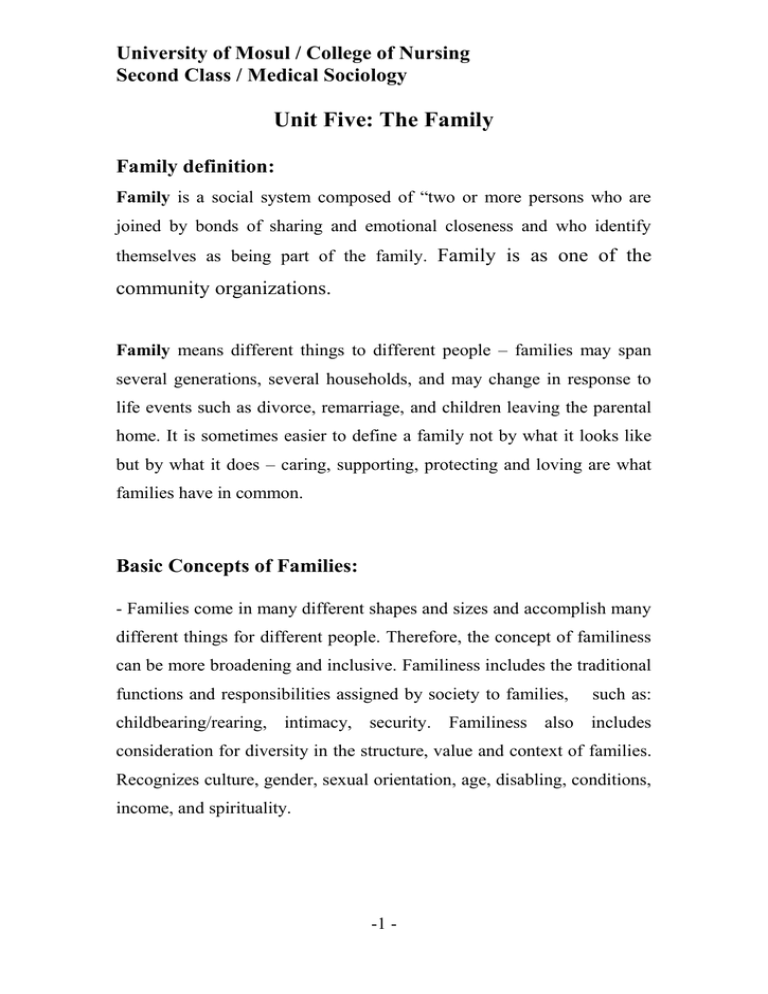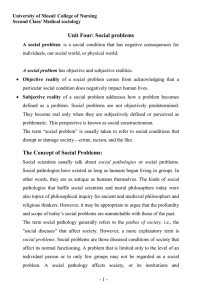University of Mosul / College of Nursing Second Class / Medical
advertisement

University of Mosul / College of Nursing Second Class / Medical Sociology Unit Five: The Family Family definition: Family is a social system composed of “two or more persons who are joined by bonds of sharing and emotional closeness and who identify themselves as being part of the family. Family is as one of the community organizations. Family means different things to different people – families may span several generations, several households, and may change in response to life events such as divorce, remarriage, and children leaving the parental home. It is sometimes easier to define a family not by what it looks like but by what it does – caring, supporting, protecting and loving are what families have in common. Basic Concepts of Families: - Families come in many different shapes and sizes and accomplish many different things for different people. Therefore, the concept of familiness can be more broadening and inclusive. Familiness includes the traditional functions and responsibilities assigned by society to families, such as: childbearing/rearing, intimacy, security. Familiness also includes consideration for diversity in the structure, value and context of families. Recognizes culture, gender, sexual orientation, age, disabling, conditions, income, and spirituality. -1 - University of Mosul / College of Nursing Second Class / Medical Sociology Traditional ideas about family: Definitions generally focus on either structure of function. Structure: the relationships among members that are based on marriage, blood, or adoption Function: tasks performed by families, such as child rearing, meeting affectional needs of adults, and transmitting the values of the larger society-traditional family tasks: Providing physical care allocating resources determining who does what assuring members’ socialization establishing interaction patterns incorporating and releasing members relating to society through its institutions maintaining morale and motivation Divorce, remarriage, and stepfamilies Rapidly growing rates of divorce and remarriage mean that the events will eventually occur in the majority of families and will thus be thought of more and more as normative events. considered a traditional family configurations recent research is emphasizing the possible positive outcomes of divorce, as opposed to only the negative results Stepfamily: a household containing a child who is biologically related to only one the adults. -2 - University of Mosul / College of Nursing Second Class / Medical Sociology Characteristics of successful stepfamilies: expectations are realistic losses can be mourned strong couple relationship satisfactory step relationships have been formed satisfying rituals have been formed the separate households cooperate Alternative ideas about families: more flexible and pluralistic than traditional approaches accept the ideas that changes in the environment often require changes in the family structure and functions, that all families do not look or behave the same, and that the same family will look or behave differently at different times Types of families: § Nuclear conjugal family § Nuclear dyad family § Dual earner family § Extended family § Single-parent family § Step-family (blended family) § Binuclear family § Cohabiting family § Communal family -3 - University of Mosul / College of Nursing Second Class / Medical Sociology § Foster family § Skip generation family Problems of Families: 1. Vulnerable families and Jobless families Families where no adult is employed are more vulnerable to some forms of disadvantage. Jobless families are more likely to be economically disadvantaged than families with employment; tend to experience poorer health outcomes; and may find it difficult to get support in times of crisis. Importantly, children growing up in jobless families are more likely to grow up jobless themselves. 2. One-parent families One-parent families refer to families where a child or children are raised in a household with only one parent present. Parents may raise children on their own for a number of reasons, such as the death of a partner; divorce or separation from a partner; or having no established relationship with the other parent of the child. 3. Indigenous families The profile of Indigenous families is different to other Australian families. Primarily, Indigenous people tend to have children at younger ages and reside in larger households than non-indigenous people. Indigenous children are more likely to grow up in one-parent families, although there are often other adults present. -4 - University of Mosul / College of Nursing Second Class / Medical Sociology 4. Families with caring responsibilities Most families have caring responsibilities at some point in the life-cycle. In addition to caring for babies and young children, families may also provide care for a member with a chronic illness or disability, or a frail aged relative. Care may be provided in the form of assistance with daily living activities; ad-hoc assistance or assistance with specific tasks; and financial assistance. 5. Families from diverse cultural and linguistic backgrounds Families from diverse cultural and linguistic backgrounds may encounter a range of challenges that are unique to their situation, such as language barriers in the community or workplace; a lack of information provided in culturally and linguistic appropriate forms; poor knowledge or understanding of Australian social practices; racist attitudes; and bullying at school or in the workplace. Depending on the reason for migration to Australia, there may also be a number of factors impinging on their health and wellbeing, such as depression, post-traumatic stress disorder, anger, stress, alienation, poverty or economic hardship, and loneliness. 6. Rural and remote families Living in a rural or remote area may have an impact on families in a number of ways. For example, it may increase the amount of time families have to travel to access education, health, and community services; or to attend work or pursue leisure activities. The range of services available may be less than that available in the city; and telecommunications and transport may be more important and less available than in urban communities. -5 - University of Mosul / College of Nursing Second Class / Medical Sociology 7. Other vulnerable families There are a number of other family types that may experience additional pressures or forms of disadvantage. In 2006-07 there were: Family Theories According to Gilliss (1991), theories used to attend to health and illness in family nursing are largely borrowed from other disciplines with the term individual often replaced with family, but the complex family unit and scope of nursing practice often not addressed. A theory is a set of propositions about defined and related constructs that describe the relationships among the variables in order to systematically describe the phenomena of interest. Theory involves concepts closely tied to individuals, groups, situations or events and tries to explain relationships between them. When ideas are less concrete, the ways phenomena are viewed and organized is sometimes referred to as a conceptual model. Conceptual models have some of the same components as theories, but are more loosely constructed and generally lack the propositions that identify the existence of relationships between concepts. For several decades, nurses have attempted to identify the knowledge that underpins family nursing and provides a foundation for practice. What theories do nurses use with families? How much of the knowledge taught in family nursing courses is derived from nursing research and how much is based upon borrowed theories? What about family health, do theories to guide practice exist? Which frameworks and theories provide the underpinnings needed to enable nurses to provide family-focused care? Many questions still need to be answered. -6 - University of Mosul / College of Nursing Second Class / Medical Sociology Family systems emphasize the whole of family, but focuses on member relationships and interactions and the functional status of the system to address needs, goals, and sustain its members. Family systems theory has evolved over the last few decades out of sociology, psychology and family sciences. While sociologists were initially concerned with describing what they discovered from structural, functional or developmental perspectives, the ideas have now melded and family systems theory has become a more general approach. A key feature of the family systems approach, especially when it is used in family therapy, is that of a unitary conceptualization of family, a whole that is different from the sum of its parts. Reuben Hill (1949), a sociologist, described a family as a group of interrelated persons forming a living system and changing over time as they acted, reacted, and met the challenges of separation, loss, and reunion that resulted from wartime challenges. This early research identified a family stress experience of adjustment that often resulted in a decrease in family functioning, disorganization, and crisis. Hill (1965) later developed the ABCX model of family stress and noted the key factors were stressor, definition or interpretation of the stressful event, and effectiveness of resources that determined whether or not life circumstances were viewed as crisis. Mc Cubbin and Patterson (1983) later expanded Hill’s model with what has been called the Double ABCX Model to address coping aspects as predictors in the post-crisis period. Mc Cubbin and Mc Cubbin (1991, 1993) building on these former models suggested what is called the Resiliency Model of Family Stress, Adjustment, and Adaptation. This model is built upon several assumptions about families (McCubbin &McCubbin, 1991): -7 - University of Mosul / College of Nursing Second Class / Medical Sociology • Families face hardships and change as natural predictable aspects of family life. • Families develop strengths and capacities to foster member and family growth and development. • Families develop unique strengths and capacities to cope with unexpected and normative stressors and foster adaptation following crisis or change. • Families benefit from and contribute networks of community relationships and resources. -8 -





